

Cigares - Hedon : Hedon. Éclatant Au premier tirage, la force du terroir français est soulignée par des arômes de cassis et de châtaignes, rafraîchis par une touche de menthe.
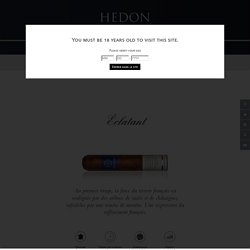
Une expression du raffinement français. OrigineFrance Temps de fumage30 min. Dimension105 x 19.84 mm ForceHigh (4/5) Eclatant Boxes Boîte en carton 10 Cigars Rêveur Créé pour un goût savoureux et doux qui, pas encore allumé, dégage des notes de pain d’épices, de lilas et de feuilles de thé séchées. OrigineFrance Temps de fumage45 min. Rêveur Boxes Boîte en carton 10 Cigars. Journal — Emil Ryge. I’ve received quite a few emails from people contemplating starting out in collodion.

Most people hit a brick wall when it comes to getting their hands on the chemistry (which is many cases is illigal to buy), so here’s a few pointers to get people started. Information First of all. Buy a book. Sure, there’s lots of info online, but a lot of it is wrong, and it takes forever to figure out what’s solid. I learned on a workshop from Quinn Jacobson, who’s book is still my go-to place for recipes and troubleshooting. Also; if you want to skip some of the most frustrating experiments take a workshop. Journal — Emil Ryge.
How to modify a normal 8x10" filmholder into a wet plate holder. La tecnica del collodio umido - fotografia. Cercando in rete si possono trovare svariate formule, faremo riferimento alla formula PoeBoy che anche se forse non è molto “performante” in termini di gradazione tonale è per certo una tra le più stabili e semplici, sopratutto per chi inizia.
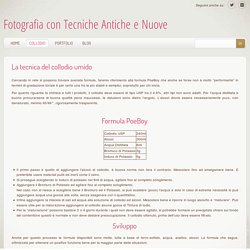
Per quanto riguarda la chimica e tutti i prodotti, il collodio deve essere di tipo USP tra il 4-6%, altri tipi non sono adatti. Per l’acqua distillata e buono procurarsene di buona qualità pena insuccessi, le delusioni sono dietro l’angolo. L’alcool dovrà essere necessariamente puro, non denaturato, minimo 95/96°, rigorosamente trasparente. 8.5×15″ silver nitrate tank with box and paddle. Pour. The classic tintype process « Wetplate Collodions. Writer / Ken Watson Also known as ferrotypes.

Ken Watson gives us the details and how-to. Always be careful when handling chemicals. Read the health and safety instructions. Wet Plate Collodion Negative and Salt Printing from Borut Peterlin on Vimeo. Varnisch vs. varnisch. Testo - foto e video di Gino Mazzanobile©2014 Era l’inizio del mese di Marzo 2014, già da qualche tempo pensavo di mettermi all’opera tentando di ottenere una vernice quasi trasparente se confrontata a quella concepita attraverso la ricetta storica del varnisch appunto il cui impiego è la gioia o il disappunto riguardo l’ultima delle operazioni previste per chi si cimenta con la tecnica del “wet plate collodion”.
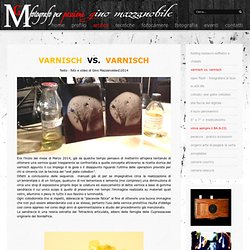
Wetplate Collodion. Getting Started InWetplate Collodion Photography By Joseph Smigiel Historically, the popularity of the wetplate process was short-lived.
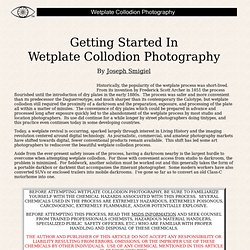
From its invention by Frederick Scott Archer in 1851 the process flourished until the introduction of dry plates in the early 1880s. The process was safer and more convenient than its predecessor the Daguerreotype, and much sharper than its contemporary the Calotype, but wetplate collodion still required the proximity of a darkroom and the preparation, exposure, and processing of the plate all within a matter of minutes. The convenience of dry plates which could be prepared in advance and processed long after exposure quickly led to the abandonment of the wetplate process by most studio and location photographers.
Today, a wetplate revival is occurring, sparked largely through interest in Living History and the imaging revolution centered around digital technology. Alexey Alexeev Photography (Ambrotypes, Tintypes, Wet-Plate Collodion) - Wet-Plate Collodion Process. Ambrotypes. Wet-Plate Collodion Process.
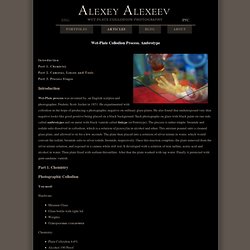
Ambrotype Introduction Wet-Plate process was invented by, an English sculptor and photographer, Frederic Scott Archer in 1851. He experimented with collodion in the hope of producing a photographic negative on ordinary glass plates. He also found that underexposed very thin negative looks like good positive being placed on a black background. Part 1. Alexey Alexeev Photography (Ambrotypes, Tintypes, Wet-Plate Collodion) - Wet-Plate Collodion Process. Ambrotypes. Wet plate collodion with a Polaroid camera « Cameras, Film & Technique. Writer and photography / Jalo Porkkala Got an old Polaroid camera sitting around somewhere?
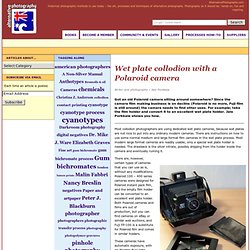
Since the camera film making business is on decline (Polaroid is no more, Fuji film is still around) the camera needs to find other uses. For example; take the film holder and convert it to an excellent wet plate holder. Jalo Porkkala shows you how. Re.note. Wet Plate Collodion Processo al collodio umido (Wet Plate Collodion Process): Nel 1846, lo Svizzero Christian Frederic Schönbein (1799-1868) sintetizza la nitrocellulosa combinando le fibre di cotone con un mix di acido nitrico e solforico.
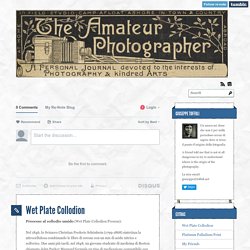
Due anni più tardi, nel 1848, un giovane studente di medicina di Boston chiamato John Parker Maynard formula un tipo di medicazione compatibile con l'epitelio, simile agli attuali cerotti liquidi, partendo dalla nitrocellulosa e chiamato “collodio” (dal greco Kollōdēs, glutinous, glue-like, simile alla colla) utilizzato appunto per curare le ferite.Nel 1850 Gustve Le Gray (1820-1884) propose che la soluzione al collodio del dott.